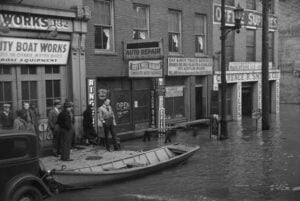The lost towns under the Lake of the Ozarks

Aerial photo of the Lake of the Ozarks. 1945.
In the heart of Missouri, the Lake of the Ozarks is a popular destination for vacationers seeking respite from the city life of St. Louis and Kansas City. With over 1,150 miles of shoreline and a surface area of 54,000 acres, the lake offers a variety of opportunities for boating, fishing, and relaxation.
The Lake of the Ozarks was created in 1931 with the completion of the Bagnell Dam, a hydroelectric project headed by the Union Electric Company (now Ameren Missouri). The dam’s construction flooded the Osage River Valley. The creation of the lake has led to many legends regarding the Lake of the Ozarks’ flooded communities.
The flooded community of Old Linn Creek
Linn Creek was the county seat of Camden County. Established in 1841, the small town was a thriving community with a courthouse, a school, and two dozen commercial buildings. It was also a stop for steamboats on the Osage River.
As the waters of the Osage River began to rise, the residents of Linn Creek abandoned their homes and relocated to higher ground. Before residents abandoned the town in the early months of 1931, most of its dozens of buildings were razed. The wooden ones were burned, including the Christian and Baptist churches. The stone and masonry structures were knocked down.
Today, the original townsite lies under 40 feet of water in Linn Creek Cove, with a new Linn Creek established on higher ground. The Old Linn Creek cemetery is the last remnant of the town. It has survived because of its location on a bluff.

Stories from the drowned town of Old Linn Creek have become urban legends. Curious visitors flock to the area in search of paranormal phenomena. Some claim they can hear an old church bell ringing from under the water.
Other Lake of the Ozarks’ flooded communities
Arnholdt’s mill was a late nineteenth-century grist mill. The mill was on the south bank of the Big Niangua River. The lake inundated the mill along with about a dozen other adjacent houses and buildings.
Irontown was a company town situated along Bollinger Creek. In 1930, around two dozen buildings, were standing when the lake flooded it. The community’s iron smelter can still be seen poking out of the water.
One can’t help but picture the Lake of the Ozarks’ flooded communities that once lay beneath the water, a reminder of sacrifices made for progress.
Other Missouri stories:
When St. Louis hosted the 1904 Summer Olympics



